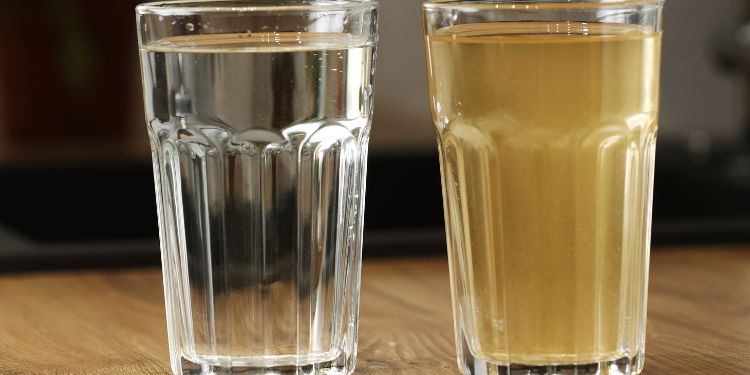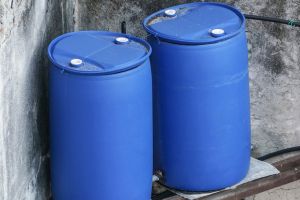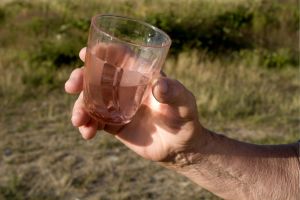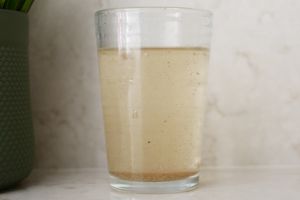I Tried Drinking Water From My Stockpile and This Is What Happened

by Fergus Mason
Without water, it doesn’t matter much what other preparations you’ve made – you’re only going to survive for a matter of days. In a crisis the mains water supply most of us rely on is likely to be cut off, and even if it isn’t there’s no guarantee the water will remain safe to drink.
Depending on what sort of emergency we’re facing, all other water sources could be contaminated, too – rivers, reservoirs, even deep wells. If you want to survive whatever the future throws at you it’s vital to have enough clean, safe water stockpiled to last you at least a few months.
This isn’t even an expensive prep, because while water is vital it’s also cheap (until the SHTF, anyway), so most preppers have a good supply of it laid up.
Stored water doesn’t last forever, though. Almost any water, unless it’s actually sterile and comes in a sealed container, is going to contain some microorganisms. Storing water for months gives these a chance to grow, and eventually they’re going to reach levels that make the water unpleasant – or even dangerous – to drink.
There are ways to slow the growth of these organisms, such as keeping water containers in a cool dark place, using opaque blue containers or even dropping a silver coin in each barrel of water, but keep it long enough and eventually things will grow in it.

That’s why, however you store your water, you should regularly empty your containers, wash them and refill them with fresh water. I keep most of my water in food-grade blue plastic barrels in my shed, and every two or three months I haul them all out, empty them, wipe down the insides with a cloth damped with a very weak bleach solution, then refill them.
I know the water in those barrels will be safe to drink whenever I need it, because their contents have never been stored for a really long time. However, I also keep a smaller stockpile in the house.
If that sounds like a lot of work, you could always try this backpack-sized water generator. I couldn’t imagine outlasting a crisis without it. It pulls clean water directly from the air, producing up to 40 gallons a day, all without being connected to the grid. My family and I have been using it for over a year, and it’s been a game-changer.
A couple of years ago I started buying orange squash in gallon jugs, and I decided that instead of throwing the jugs out when they were empty I’d wash them out, fill them with water and store them away wherever I had space, just to give me a few days’ extra reserves if I needed it.
.jpg) “A few days” slowly expanded to a couple of weeks’ worth, which is definitely useful. However, while I try to empty and refill the jugs regularly, sometimes some of them get overlooked.
“A few days” slowly expanded to a couple of weeks’ worth, which is definitely useful. However, while I try to empty and refill the jugs regularly, sometimes some of them get overlooked.
I was checking my stockpiles last week and found a few that had been overlooked for a long time – two years, in one case. I’m not completely sure why, but instead of just washing out and refilling the containers, I decided to drink some of it to see how it had handled being stored.
Stored for One Year
I started with a jug that’s been in the storage space under my stairs for just over a year. The temperature is pretty stable in there and it isn’t in direct sunlight, but it isn’t very dark either. Once I’d brushed some dust off the jug its contents looked fine – perfectly clear, with no signs of anything growing. That was a promising start, so I poured myself a glass and tried it.
I have to say it wasn’t the most pleasant water I’ve ever drunk, but it wasn’t actually terrible either.

It was very flat and deoxygenated, with a slight aftertaste. In an emergency I wouldn’t hesitate to drink water that tasted like that.
However, taste isn’t everything, and I wanted to see if it was going to have any more serious issues.
So I drank a 12oz glass of it.
I figured that if the water was going to make me ill, 12oz should be enough to find out without actually killing me (even my curiosity has limits), so after drinking it I waited a few hours to see if anything was going to happen. Nothing did. If I was short of water, I’d be happy to drink the contents of this jug. Apart from the taste, of course – but it turned out that if I made tea with it, it was fine.
Stored for Two Years
After that I decided to try another jug, this one from my kitchen. I have an odd and generally useless space down the side of my kitchen cupboard, and when it turned out to be just wide enough for a gallon jug to slip in, I stored a dozen of them in there.
Most of those jugs got rotated out, washed and refilled fairly regularly, but a couple right at the back got overlooked – and when I finally dug them out and checked the refill dates written on them, they were more than two years old.
I could tell right away this water wasn’t in as good condition as the first jug I’d tried. It had a cloudy look. It wasn’t actually murky – I wasn’t expecting the creature from the Black Lagoon to come shambling out of it – but it definitely wasn’t crystal clear.
It also had a very obvious stale smell when I opened and sniffed it. Still, beggars can’t be choosers, and if this was the last gallon of water I had in a crisis, I couldn’t afford to pour it away just because it smelled a bit funny. Determined to test it, I poured another 12oz glass.
 However, one sip was enough to persuade me not to drink it. This water tasted seriously unpleasant, and it wasn’t just flat and stale; there was a sort of biological, vaguely swampy taste to it. I got the feeling that if I drank it, it would make me ill.
However, one sip was enough to persuade me not to drink it. This water tasted seriously unpleasant, and it wasn’t just flat and stale; there was a sort of biological, vaguely swampy taste to it. I got the feeling that if I drank it, it would make me ill.
So, straight from the jug, I’d say this water wasn’t safe to drink.
It was still a gallon of water, though, and in a survival situation that could mean several more days of life. Would I really reject it? Of course it could still be used for washing and so on, but I wanted it drinkable.
So I poured a pint of it into my filter jug and let it run through. That got rid of the cloudiness and most of the taste. Next, I boiled it – just in the kettle, not the ten minutes at a rolling boil you’d give it for sterilization – and made tea. The tea tasted fine, and after drinking it I was fine, too.
Finally I did put another pint of it through a ten-minute boil. Once it had cooled, apart from the usual flat, oxygen-free taste of boiled water, it was definitely drinkable. So I drank a whole glass of it and, next day, it was clear I’d got away with it.
What Did I Learn?
Well, I learned that it’s important to store water properly – ideally not in clear plastic jugs that do get some indirect sunlight – and to rotate it regularly.
Leaving it in a container for three, or even six, months shouldn’t have any real impact on its safety or taste, as long as it isn’t exposed to too much heat. A year, though, and you’ll start to notice its age when you taste it.
Even if you’ve stored water for much longer than it should have been, it can still be salvaged. Just treat it like water from a river or pond, and it should be fine – filter it, then sterilize either by boiling or chemical treatment. It might not be the best tasting water ever, but it will still save your life.
If you have a backyard and access to rainwater, you’re already ahead of the game when it comes to water security. To take full advantage of this, you should up this simple DIY rainwater harvesting system that not only collects but also purifies your water for drinking.
This system is easy to build and can store up to 165 gallons of rainwater that would otherwise go to waste. By incorporating filters and other purification methods, you can ensure a steady supply of safe, drinkable water even in an emergency.
Anyone can join.
Anyone can contribute.
Anyone can become informed about their world.
"United We Stand" Click Here To Create Your Personal Citizen Journalist Account Today, Be Sure To Invite Your Friends.
Before It’s News® is a community of individuals who report on what’s going on around them, from all around the world. Anyone can join. Anyone can contribute. Anyone can become informed about their world. "United We Stand" Click Here To Create Your Personal Citizen Journalist Account Today, Be Sure To Invite Your Friends.
LION'S MANE PRODUCT
Try Our Lion’s Mane WHOLE MIND Nootropic Blend 60 Capsules
Mushrooms are having a moment. One fabulous fungus in particular, lion’s mane, may help improve memory, depression and anxiety symptoms. They are also an excellent source of nutrients that show promise as a therapy for dementia, and other neurodegenerative diseases. If you’re living with anxiety or depression, you may be curious about all the therapy options out there — including the natural ones.Our Lion’s Mane WHOLE MIND Nootropic Blend has been formulated to utilize the potency of Lion’s mane but also include the benefits of four other Highly Beneficial Mushrooms. Synergistically, they work together to Build your health through improving cognitive function and immunity regardless of your age. Our Nootropic not only improves your Cognitive Function and Activates your Immune System, but it benefits growth of Essential Gut Flora, further enhancing your Vitality.
Our Formula includes: Lion’s Mane Mushrooms which Increase Brain Power through nerve growth, lessen anxiety, reduce depression, and improve concentration. Its an excellent adaptogen, promotes sleep and improves immunity. Shiitake Mushrooms which Fight cancer cells and infectious disease, boost the immune system, promotes brain function, and serves as a source of B vitamins. Maitake Mushrooms which regulate blood sugar levels of diabetics, reduce hypertension and boosts the immune system. Reishi Mushrooms which Fight inflammation, liver disease, fatigue, tumor growth and cancer. They Improve skin disorders and soothes digestive problems, stomach ulcers and leaky gut syndrome. Chaga Mushrooms which have anti-aging effects, boost immune function, improve stamina and athletic performance, even act as a natural aphrodisiac, fighting diabetes and improving liver function. Try Our Lion’s Mane WHOLE MIND Nootropic Blend 60 Capsules Today. Be 100% Satisfied or Receive a Full Money Back Guarantee. Order Yours Today by Following This Link.







